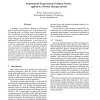RE
2006
Springer
14 years 2 months ago
2006
Springer
Scenarios and goals are effective techniques for requirements definition. Goals are objectives that a system has to meet. They are elaborated into a structure that decomposes decla...
RE
2006
Springer
14 years 2 months ago
2006
Springer
Literature tends to discuss software (and system) requirements quality control, which includes validation and verification, as a heterogeneous process using a great variety of rel...
RE
2006
Springer
14 years 2 months ago
2006
Springer
Assumptions are frequently made during requirements analysis of a system about the trustworthiness of its various components (including human components). These trust assumptions, ...
RE
2006
Springer
14 years 2 months ago
2006
Springer
Pre-requirements specification tracing concerns the identification and maintenance of relationships between requirements and the knowledge and information used by analysts to info...
RE
2006
Springer
14 years 2 months ago
2006
Springer
In the last decade, software product management has received much practical attention, though research in this area is still scattered. In this paper, we present a reference frame...
RE
2006
Springer
14 years 2 months ago
2006
Springer
The challenges to requirements from linguistic factors are well-known. This work concerns an approach to communicating requirements with greater fidelity among stakeholders throug...
RE
2006
Springer
14 years 2 months ago
2006
Springer
Use-cases often capture the expected behaviors of a system and its components. During requirements analysis, it is important to understand and model the relationship among differe...
RE
2006
Springer
14 years 2 months ago
2006
Springer
A technique is presented for obtaining a specification from a requirement through a series of incremental steps. The starting point is a Problem Frame description involving a requ...
RE
2006
Springer
14 years 2 months ago
2006
Springer
This paper describes an experience in requirements engineering for an open source E-Learning tool selection. The process meets the challenges of software selection such as the int...
RE
2006
Springer
14 years 2 months ago
2006
Springer
Terminological interference occurs in requirements engineering when stakeholders vary in the concepts they use to understand a problem domain, and the terms they use to describe t...




